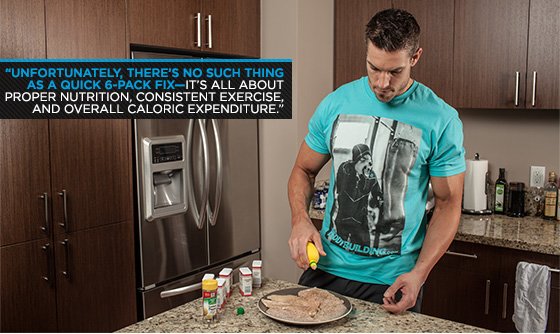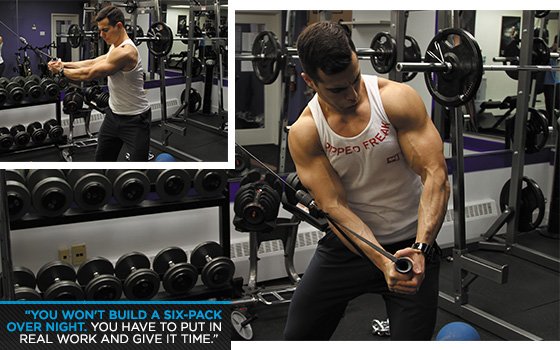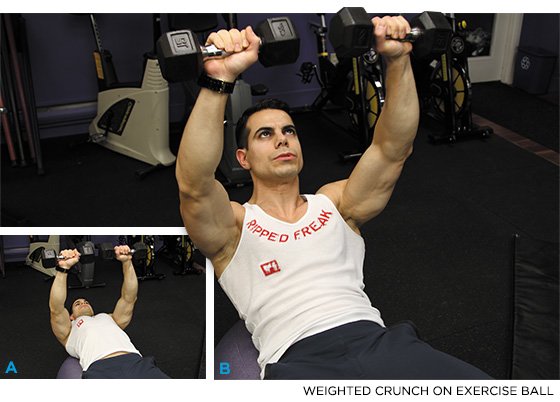Vital Stats
- Name: Alex Savva
- Occupation: Founder of CircuitFIT, co-founder of Pharmafreak and SD Pharmaceuticals
- Education: BA in physical health and education, University of Toronto
- Website(s): PharmaFreak.com and SDpharmaceuticals.com
As a personal trainer, I'm constantly bombarded with questions about how to build six-pack abs. My clients want to know the best core exercises, what to eat, and how to train for best results.
To help you complete your own quest for a chiselled middle, I've gathered and answered my clients' top 10 questions into one supercharged six-pack article. Start shredding!
1. Are Crunches the Best Way to Get Ripped Abs?
No. Crunches work your abs, but there are more effective core-centric exercises. A study from San Diego State University showed that the vertical chair knee raise, for example, stimulates up to 210 percent more abdominal activity than a regular crunch!
Core muscles are also an integral part of deadlifts and squats, both of which are more effective than crunches. They also burn more calories, giving you extra bang for each rep you perform.
2. How Should I Train for Maximum Fat Loss?
Go hard and go heavy. High-intensity exercise has been shown to stimulate lipolytic hormones, including growth hormone and epinephrine, which promote greater post-exercise energy expenditure and fat burning.1 This after-burn effect is associated with a boost in metabolism, known as excess post-exercise oxygen consumption (EPOC).
High-volume, whole-body resistance training significantly elevates resting energy expenditure up to 72 hours after exercise in both trained and untrained subjects.2,3 In fact, a study from the National Taiwan Normal University found that EPOC after training with heavier weights—75 percent of one rep max (1RM)—is higher than after training with lighter weights at 50 percent of 1RM.
Basically, the heavier and harder you train in the gym, the more you burn when you're done lifting.
3. Why is Stomach Fat So Hard to Lose?
Everyone's different, but the stomach is generally the body's favorite place to store and hold fat—even on a strict diet and fitness plan. When I was competing in bodybuilding, my lower abs were the last to appear before a show. Hormonal changes that result from lack of proper sleep, stress, and aging add more fat to your waistline.

Unfortunately, there's no such thing as a quick fix—it's all about proper nutrition, consistent exercise, and overall caloric expenditure.
4. How Long Will it Take to Get a Six-pack?
This is probably the most common question we hear from our clients at CircuitFIT. There's no sure-fire answer because so many factors are involved, including your current body fat, your fitness level, your exercise routine, your diet, stress, and your sleep duration and quality.
Regardless, you won't build a six-pack overnight. You have to put in real work and give it time. Get a fitness and nutrition plan together and follow it consistently for at least 12 weeks before you expect to see noticeable results.
5. What Should I Eat in Order to Get Ripped Abs?
Fewer carbohydrates and more protein! Stick to nutritious carbs like whole grains and vegetables, and make sure each meal or snack contains a lean protein source like chicken, fish, or non-fat Greek yogurt. Don't be afraid of fat, however. Include good fats from fish, fish oil, nuts, olives and avocados in your diet.
I personally have 3-4 whole-food meals and 1-2 protein shakes per day. I have my shakes pre- and post-workout on training days. It's all about choosing whole fruits and vegetables, and nutrient-dense, complex carbs. My diet includes whole eggs, yams, Greek yogurt, fish, chicken, beef, nuts, olive oil, almond butter, fruits, vegetables, quinoa, and other nutritious grains.

6. Can I Get Ripped by Taking a Supplement?
Remember that supplements need to supplement something. If you want to get ripped and build muscle, you have to get off your butt and do the work! I always recommend that my clients have a solid training and nutrition regimen in place before they add supplements to their programs. When you're ready to add a fat-burning product, choose one with ingredients backed by published studies.
Caffeine, CH-19 Sweet Red Pepper Extract, and raspberry ketone are all backed by quality research. These are some of the ingredients we use in our PharmaFreak fat burner, Ripped Freak.
7. Will I Be Able to Maintain My Results Once I Stop Using a Fat Burner?
Of course! As long as you continue to train hard and follow a solid nutrition plan, you'll maintain your results sans supplements. Most people eat super clean and train harder than ever while taking supplements, but go back to their old, lazy ways once they stop. This leads to the dreaded "yo-yo syndrome," which destroys hard-earned results. Consistency is the key.
8. Is it Easier for Men or Women to Get Ripped Abs?
In general, men can achieve six-pack status easier than women because they produce more testosterone, allowing them to build more muscle mass and burn more calories while exercising and resting.
Women have a harder time because of their hormonal and muscular makeup, which is one of the main reasons we emphasize compound—or functional—lifts with our female clients.
That said, the older we get, the harder it becomes for both sexes to get a six-pack. Our hormone levels naturally decline. However, research shows that strength training can increase lean muscle tissue and strength, which helps us stay ripped.
Pumping iron is the key. Proper nutrition and supplements can also help naturally raise key muscle-building and fat-burning hormones.
9. What if You Don't Want the Six-pack, but Just a Flat Stomach?
Wait, who doesn't want a six-pack? OK, even if you just want a flat stomach, I recommend you train your abs from all angles 3-5 times per week to build a strong core that not only looks good but also helps you perform better and stay injury-free. Check out my favorite abs exercises.
10. What Are the Biggest Mistakes People Make When it Comes to Getting Flat Abs?
Ninety-nine percent of the time, when clients aren't achieving desired results, they're consuming too many calories, making bad food choices, or both. You can avoid this by tracking your progress. In addition to writing down reps and sets, keep a food journal. Documenting your daily progress is extremely valuable because it allows you to look back, review, and tweak your plan.

Everyone responds differently, so to determine what works best, get to know your body and listen to its feedback.
References
- Irving, B.A., & Davis, C.K., et al. (2008). Effect of Exercise Training Intensity on Abdominal Visceral Fat and Body Composition. Med Sci Sports Exerc, Oct 8.
- Schuenke M.D., & Mikat R.P., et al. (2002). Effect of an acute period of resistance exercise on excess post-exercise oxygen consumption. Eur J Appl Physiol, 86(5):411-7.
- Hackney K.J. & Engels H.J., et al. (2008). Resting energy expenditure and delayed-onset muscle soreness after full-body resistance training with an eccentric concentration. J Strength Cond Res, Sep;22(5):1602-9.

